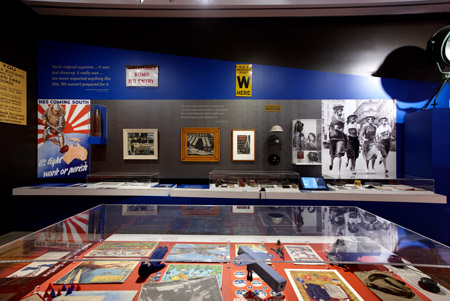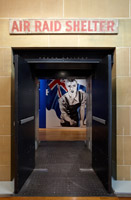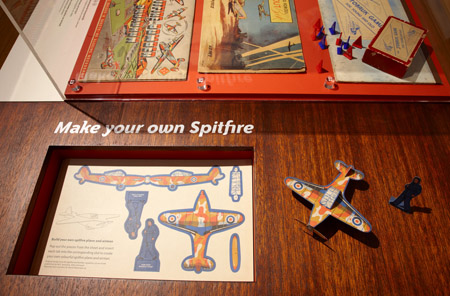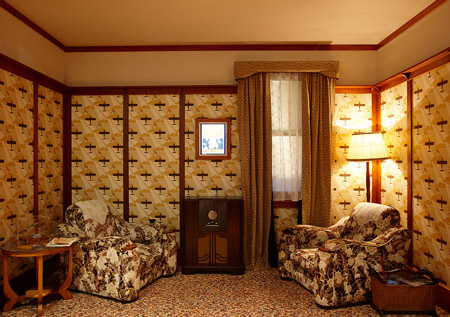Home Front
The Second World War ‘shaped, challenged and changed the lives of generations of Australians’, this exhibition at the Museum of Sydney boldly announces at the entry to the exhibition. Note, not just one generation. A big claim, then. The test for any visitor will be to see if Home Front justifies that claim. I think that it does, though perhaps – apart from its opening statement – in an understated way, which seems to be the approach of most museums in this country. I would have preferred a bit more shouting in Home Front, as there is much to shout about.

photograph by Jenni Carter, 2012
Museum of Sydney, Historic Houses Trust of NSW
What is meant by the concept of the ‘home front’ which we throw around so readily now? I’ve come to believe that the home front is a series of ideas concerning what happens to a people when their country is at war – all that happens to those people during the years of war, including what is happening to those in uniform at home and abroad. The home front is not so much a place as an event. This exhibition does not quite go that far. It wants to show you how people in Sydney lived through the war: at home, at work, and in their heads and hearts. A big ambition that mostly comes off.

photograph by Jenni Carter, 2012
Museum of Sydney, Historic Houses Trust of NSW
There is a pleasing variety of materials and objects in Home Front, including posters, photos, paintings, video, audio and a wide variety of bits and pieces. There are, for example, an unexploded shell that lobbed into the eastern suburbs of Sydney, and a Tobruk board game that appears to be of movement and challenges, although the game is still in its box. Another board game recreates the attack on Sydney in May 1942. I’d not seen anything like this before. Also, in this one compelling display case, is a jigsaw of Their Majesties in all their finery, the King with his crown firmly atop. I’m hopeless at jigsaws and pleasingly this one is finished because I can’t imagine the frustration of trying to put all that regal gold in order. So full marks for the variety of the material on display.

photograph by Jenni Carter, 2012
Museum of Sydney, Historic Houses Trust of NSW
There is also a surprisingly large amount of manuscript material in Home Front that repays close perusal. Through telegrams, letters, photos, and legal and government documents the reader can trace the last days of John Leonard Jago of Haberfield, Sydney, a member of 460 Squadron killed over Europe. There is even an official letter from September 1945 telling the grieving family where their son’s grave is. Until this, I didn’t know they sent such letters out. There are other documentary collections relating to marriage and loneliness and news from the battle front. The Jago fragment of Home Front is engaging and deeply moving and tells us of the commemorative nature of much of museum work.
Most of the material in the exhibition comes from other museums and galleries, as might have been expected. Many of the photos, paintings, posters and letters come from the Australian War Memorial. Hats off to Annie Campbell, curator, and Kate Bruxner, assistant curator, for selecting so judiciously and sensitively. I was delighted to be reunited with John Frith’s bust of wartime prime minister Robert Menzies, which used to sit in a bookshelf in my office at the Australian War Memorial – almost the first time the Menzies bust has been on display, I think. The quantity of the material in this exhibition on loan from Canberra indicates what an extraordinary home front exhibition from either war the Australian War Memorial could mount.

photograph by Jenni Carter, 2012
Museum of Sydney, Historic Houses Trust of NSW
Home Front tells us much about the impact of war on Australian society and much about the loyalty and nobility of an earlier generation of Australians. You can see glimpses of how that war moved across generations, although this might have been made more explicit. For me one of the most touching aspects of the exhibition was the deep engagement, almost reverence, of the visitors. I saw people studying, in detail, captions and objects and sharing reminiscences with other visitors. People listened to the audio guide with close attention, and the specially made video on life in Sydney during the war always had an audience. ‘True to life’ was one comment on the cleverly scrolling visitors’ postcards which replaced the comments book usually found in such exhibitions. I was equally interested to read the comments of younger visitors when they identified themselves. This was clearly an exhibition for all ages.
Michael McKernan is a Canberra-based historian who has written several books about the home front in Australia during the First and Second world wars.
| Exhibition: | Home Front: Wartime Sydney 1939–1945 |
| Institution: | Historic Houses Trust of New South Wales |
| Curator: | Annie Campbell |
| Exhibition design: | Wendy Osmond |
| Graphic design: | Bruce Smythe |
| Venue/dates: |
Museum of Sydney, 31 March – 9 September 2012 |
| Floor space: | 189 square metres |
